Characterization of Envelope Air Leakage Behavior for Centrally Air-Conditioned Single-Family Detached Houses
Abstract
1. Introduction
- Developing regulations and checking compliance.
- Increasing the accuracy and reliability of input data for building energy performance assessment of future and current construction [65].
- Helping to guide designers and decision-making personnel [66].
- Highlighting factors affecting building airtightness locally and evaluating the building design and construction quality [67].
- Evaluating the time impact on building air tightness [68].
- Assessing the progress of the building stock in meeting the emerging energy requirements [69].
- Creating a base for comparison of the built stock between countries [70].
2. Materials and Methods
3. Characterization of Air Leakage Behavior: A Case Study
3.1. Experimental System and Setup
- All interior doors should be opened during the test to create a uniform pressure within the house.
- Fireplace and operable dampers should be closed, and HVAC system balancing dampers should not be adjusted.
- The multiplication of the outdoor/indoor temperature difference (K) with the building height (m) should not exceed 500 m. Because the pressure difference induced by the stack effect will be too large to allow an accurate interpretation of the results.
- The building volume and wind velocity during the test should not exceed 4000 m3 and 2.0 m/s, respectively.
3.2. Envelope Airtightness Characterization
3.3. Estimation of Air Leakage Rate
4. Results and Discussion
4.1. Characterization of Envelope Airtightness
4.2. Estimation of Air Leakage
5. Conclusions
Author Contributions
Funding
Data Availability Statement
Acknowledgments
Conflicts of Interest
References
- Kölsch, B.; Walker, I.S.; Schiricke, B.; Delp, W.W.; Hoffschmidt, B. Quantification of air leakage paths: A comparison of airflow and acoustic measurements. Int. J. Vent. 2021, 1–21. [Google Scholar] [CrossRef]
- IEA. Global CO2 Emissions from the Operation of Buildings Rebounded in 2021 to above 2019 Levels. 2022. Available online: https://www.iea.org/reports/buildings# (accessed on 26 February 2023).
- International Energy Agency. World Energy Outlook 2019; IEA: Paris, France, 2019; Available online: https://www.iea.org/reports/world-energy-outlook-2019 (accessed on 1 June 2020).
- Abuhussain, M.A.; Chow, D.H.C.; Sharples, S. Assessing the adaptability of the Saudi residential building’s energy code for future climate change scenarios. In Proceedings of the 34th International Conference on Passive and Low Energy Architecture, Hong Kong, China, 10–12 December 2018. [Google Scholar]
- Dubey, K.; Nicholas, H.; Moncef, K. Evaluating Building Energy Efficiency Investment Options for Saudi Arabia, Riyadh, Kapsarc (2016). pp. 1–64. Available online: https://www.kapsarc.org/wp-content/uploads/2016/10/KS-1655-DP049A-Evaluating-Building-Energy-Efficiency-Investment-Options-for-SA_web.pdf (accessed on 26 February 2023).
- Felimban, A.; Prieto, A.; Knaack, U.; Klein, T.; Qaffas, Y. Residential Buildings in Jeddah, Saudi Arabia. Buildings 2019, 9, 163. [Google Scholar] [CrossRef]
- Esmaeil, K.K.; Alshitawi, M.S.; Almasri, R.A. Analysis of energy consumption pattern in Saudi Arabia’s residential buildings with specific reference to Qassim region. Energy Effic. 2019, 12, 2123–2145. [Google Scholar] [CrossRef]
- Almasri, R.A.; Almarshoud, A.F.; Omar, H.M.; Esmaeil, K.K.; Alshitawi, M. Exergy and Economic Analysis of Energy Consumption in the Residential Sector of the Qassim Region in the Kingdom of Saudi Arabia. Sustainability 2020, 12, 2606. [Google Scholar] [CrossRef]
- Younes, C.; Shdid, C.A.; Bitsuamlak, G. Air infiltration through building envelopes: A review. J. Build. Phys. 2011, 35, 267–302. [Google Scholar] [CrossRef]
- Gillott, M.C.; Loveday, D.L.; White, J.; Wood, C.J.; Chmutina, K.; Vadodaria, K. Improving the airtightness in an existing UK dwelling: The challenges, the measures and their effectiveness. Build. Environ. 2016, 95, 227–239. [Google Scholar] [CrossRef]
- Johnston, D.K.; Miles-Shenton, D.; Bell, M.; Wingfield, J. Airtightness of Buildings—Towards Higher Performance: Final Report—Domestic Sector Airtightness; Department for Communities and Local Government: London, UK, 2011.
- Zmeureanu, R. Cost-Effectiveness of Increasing Airtightness of Houses. J. Arch. Eng. 2000, 6, 87–90. [Google Scholar] [CrossRef]
- Cardoso, V.E.M.; Pereira, P.F.; Ramos, N.M.M.; Almeida, R.M.S.F. The Impacts of Air Leakage Paths and Airtightness Levels on Air Change Rates. Buildings 2020, 10, 55. [Google Scholar] [CrossRef]
- Emmerich, S.J.; Persily, A.K. Energy impacts of infiltration and ventilation in US office buildings using multi-zone airflow simulation. Proc. IAQ Energy 1998, 98, 191–206. [Google Scholar]
- Osipov, A.; Meesb, P.; Vermeif, G. Low-Frequency Airborne Sound Transmission through Single Partitions in Buildings. Appl. Acoust. 1997, 52, 3. [Google Scholar] [CrossRef]
- Persily, A. Repeatability and accuracy of pressurization testing. In Proceedings of the ASHRAE/DOE Conference on Thermal Performance of the Exterior Envelope of Buildings, Las Vegas, NV, USA, 6–9 December 1982. [Google Scholar]
- ASTM E779-10; Standard Test Method for Determining Air Leakage Rate by Fan Pressurization. American Society for Testing and Materials: Philadelphia, PA, USA, 2010.
- Sherman, M.H.; Chan, R. Building Airtightness: Research and Practice; Lawrence Berkeley National Laboratory Report No. LBNL-53356; Building Technology and Urban Systems Division: Berkeley, CA, USA, 2004.
- Jokisalo, J.; Kalamees, T.; Kurnitski, J.; Eskola, L.; Jokiranta, K.; Vinha, J. A Comparison of Measured and Simulated Air Pressure Conditions of a Detached House in a Cold Climate. J. Build. Phys. 2008, 32, 67–89. [Google Scholar] [CrossRef]
- Prignon, M.; Van Moeseke, G. Factors influencing airtightness and airtightness predictive models: A literature review. Energy Build. 2017, 146, 87–97. [Google Scholar] [CrossRef]
- Sherman, M.H. Estimation of infiltration from leakage and climate indicators. Energy Build. 1987, 10, 81–86. [Google Scholar] [CrossRef]
- Bramiana, C.; Entrop, A.G.; Halman, J.I.M. Relationships between Building Characteristics and Airtightness of Dutch Dwellings. Energy Procedia 2016, 96, 580–591. [Google Scholar] [CrossRef]
- Sfakianaki, A.; Pavlou, K.; Santamouris, M.; Livada, I.; Assimakopoulos, M.-N.; Mantas, P.; Christakopoulos, A. Air tightness measurements of residential houses in Athens, Greece. Build. Environ. 2008, 43, 398–405. [Google Scholar] [CrossRef]
- Feijó-Muñoz, J.; Pardal, C.; Echarri, V.; Fernández-Agüera, J.; Assirgo de Larriva, R.; Montesdeoca Calderín, M.; Poza-Casado, I.; Padilla-Marcos, M.; Meiss, A. Energy impact of the air infiltration in residential buildings in the Mediterranean area of Spain and the Canary islands. Energy Build. 2019, 188–189, 226–238. [Google Scholar] [CrossRef]
- Dickerhoff, D.J.; Grimsrud, D.T.; Lipschutz, R.D. Component Leakage Testing in Residential Buildings; Ernest Orlando Lawrence Berkeley National Laboratory: Berkeley, CA, USA, 1982.
- Etheridge, D.W. Air leakage characteristics of houses—A new approach. Build. Serv. Eng. Res. Technol. 1984, 5, 32–36. [Google Scholar] [CrossRef]
- Gadsby, K.J.; Harrje, D.T. Fan pressurization of building: Standards, calibration, and field experience. Build. Eng. 1985, 91, 95–104. [Google Scholar]
- Persily, A.K.; Grot, R.A. Accuracy in pressurization data analysis. ASHRAE Trans. 1985, 91, 105–119. [Google Scholar]
- Brinks, P.; Kornadt, O.; Oly, R. Air infiltration assessment for industrial buildings. Energy Build. 2015, 86, 663–676. [Google Scholar] [CrossRef]
- Kempton, L.; Daly, D.; Kokogiannakis, G.; Dewsbury, M. A rapid review of the impact of increasing airtightness on indoor air quality. J. Build. Eng. 2022, 57, 104798. [Google Scholar] [CrossRef]
- Walker, I.S.; Wilson, D.J.; Sherman, M.H. A comparison of the power law to quadratic formulations for air infiltration calculations. Energy Build. 1998, 27, 293–299. [Google Scholar] [CrossRef]
- Sherman, M. A Power-Law Formulation of Laminar Flow in Short Pipes. J. Fluids Eng. 1992, 114, 601–605. [Google Scholar] [CrossRef]
- Kukadia, V.; Upton, S. Ensuring Good Indoor Air Quality in Buildings; BRE Trust: Watford, UK, 2019. [Google Scholar]
- Logue, J.M.; Sherman, M.H.; Walker, I.S.; Singer, B.C. Energy impacts of envelope tightening and mechanical ventilation for the U.S. residential sector. Energy Build. 2013, 65, 281–291. [Google Scholar] [CrossRef]
- Lozinsky, C.H.; Touchie, M.F. Improving energy model calibration of multi-unit residential buildings through component air infiltration testing. Build. Environ. 2018, 134, 218–229. [Google Scholar] [CrossRef]
- Emmerich, S.J.; Persily, A.K.; Mcdowell, T.P. Impact of Infiltration on Heating and Cooling Loads in U.S. Office Buildings. In Proceedings of the 26th AIVC Conference Ventilation in Relation to the Energy Performance of Buildings, Brussels, Belgium, 21–23 September 2005. [Google Scholar]
- Genge, C. Controlling air leakage int tall buildings. ASHRAE J. 2009, 51, 50–60. [Google Scholar]
- ASTM E741–00; Standard Test Method for Determining Air Change in a Single Zone by Means of a Tracer Gas Dilution. American Society for Testing and Materials: West Conshohocken, PA, USA, 2000.
- Zheng, X.; Cooper, E.; Gillott, M.; Wood, C. A practical review of alternatives to the steady pressurisation method for de-termining building airtightness. Renew. Sustain. Energy Rev. 2020, 132, 110049. [Google Scholar] [CrossRef]
- Walker, I.S.; Sherman, M.H.; Joh, J.; Chan, W.R. Applying large datasets to developing a better understanding of air leakage measurement in homes. Int. J. Vent. 2013, 11, 323–338. [Google Scholar] [CrossRef]
- Jokisalo, J.; Kurnitski, J.; Korpi, M.; Kalamees, T.; Vinha, J. Building leakage, infiltration, and energy performance analyses for Finnish detached houses. Build. Environ. 2009, 44, 377–387. [Google Scholar] [CrossRef]
- Poza-Casado, I.; Cardoso, V.E.M.; Almeida, R.M.S.F.; Meiss, A.; Ramos, N.M.M.; Padilla-Marcos, M.Á. Residential buildings airtightness frameworks: A review on the main databases and setups in Europe and North America. Build. Environ. 2020, 183, 107221. [Google Scholar] [CrossRef]
- Buning, L.; Store, I.S.O. Thermal performance of buildings—Determination of air permeability of buildings—Fan pressurization method. Internaional Stand. ISO 9972 2006, 2006, 28. [Google Scholar] [CrossRef]
- ASTM E779-19; Standard Test Method for Determining Air Leakage Rate by Fan Pressurization. ASTM International: West Conshohocken, PA, USA, 2010; Volume i, pp. 1–11. [CrossRef]
- Delmotte, C. Airtightness of Buildings-Considerations regarding the Zero-Flow Pressure and the Weighted Line of Organic Correlation. In Proceedings of the 38th AIVC Conference “Ventilating Healthy Low-Energy Buildings”, Nottingham, UK, 13–14 September 2017. [Google Scholar]
- Carrié, F.R.; Leprince, V. Uncertainties in building pressurisation tests due to steady wind. Energy Build. 2016, 116, 656–665. [Google Scholar] [CrossRef]
- Hult, E.L.; Sherman, M.H. Estimates of Uncertainty in Multi-Zone Air Leakage Measurements. Int. J. Vent. 2014, 12, 359–368. [Google Scholar] [CrossRef]
- Delmotte, C. Airtightness of buildings-Calculation of combined standard uncertainty. In Proceedings of the 34th AIVC Conference “Energy Conservation Technologies for Mitigation and Adaptation in the Built Environment: The Role of Ventilation Strategies and Smart Materials”, Athens, Greece, 25–26 September 2013. [Google Scholar]
- Delmotte, C.; Laverge, J. Interlaboratory tests for the determination of repeatability and reproducibility of buildings airtightness measurements. In Proceedings of the 2nd AIVC Conference “Towards Optimal Airtightness Performance”, Brussels, Belgium, 12–13 October 2011. [Google Scholar]
- Persily, A.K. Air Flow Calibration of Building Pressurization Devices; US Department of Commerce, National Bureau of Standards: Washington, DC, USA, 1984.
- Modera, M.P.; Wilson, D.J. The effects of wind on residential building leakage measurements. In Air Change Rate and Airtightness in Buildings; ASTM International: West Conshohocken, PA, USA, 1990. [Google Scholar]
- Siren, K. A modification of the power-law equation to account for large scale wind turbulence. In Proceedings of the 18th AIVC Conference “Ventilation and Cooling”, Athens, Greece, 23–24 September 1997; Volume 2, pp. 557–566. [Google Scholar]
- Sherman, M.; Palmiter, L. Uncertainties in Fan Pressurization Measurements. In Airflow Performance of Building Envelopes, Components, and Systems; ASTM International: West Conshohocken, PA, USA, 1995; pp. 266–283. [Google Scholar] [CrossRef]
- Love, J.; Wingfield, J.; Smith, A.; Biddulph, P.; Oreszczyn, T.; Lowe, R.; Elwell, C. ‘Hitting the target and missing the point’: Analysis of air permeability data for new UK dwellings and what it reveals about the testing procedure. Energy Build. 2017, 155, 88–97. [Google Scholar] [CrossRef]
- Mélois, A.B.; Moujalled, B.; Guyot, G.; Leprince, V. Improving building envelope knowledge from analysis of 219,000 certified on-site air leakage measurements in France. Build. Environ. 2019, 159, 106145. [Google Scholar] [CrossRef]
- Kurnitski, J.; Saari, A.; Kalamees, T.; Vuolle, M.; Niemelä, J.; Tark, T. Cost Optimal and Nearly Zero (nZEB) Energy Performance Calculations for Residential Buildings with the Federation of European Heating, Ventilation and Air Conditioning Association Definition for nZEB National Implementation. Energy Build. 2011, 43, 3279–3288. [Google Scholar] [CrossRef]
- Hassid, S.; Santamouris, M.; Papanikolaou, N.; Linardi, A.; Klitsikas, N.; Georgakis, C.; Assimakopoulos, D. The effect of the Athens heat island on air conditioning load. Energy Build. 2000, 32, 131–141. [Google Scholar] [CrossRef]
- Ren, Z.; Chen, D. Estimation of air infiltration for Australian housing energy analysis. J. Build. Phys. 2014, 39, 69–96. [Google Scholar] [CrossRef]
- Water & Electricity Regulatory Authority (WERA), Energy Sales by Consumption Categories and Year, 2023. Available online: https://wera.gov.sa/Statistics/NRDetailsC1?CategoryId=6&SheetsId=20 (accessed on 10 February 2023).
- Heim, D.; Miszczuk, A. Modelling building infiltration using the airflow network model approach calibrated by air-tightness test results and leak detection. Build. Serv. Eng. Res. Technol. 2020, 41, 681–693. [Google Scholar] [CrossRef]
- Mortensen, L.H.; Bergsøe, N.C. Air tightness measurements in older Danish single-family houses. Energy Procedia 2017, 132, 825–830. [Google Scholar] [CrossRef]
- Alfano, F.D.A.; Dell’Isola, M.; Ficco, G.; Tassini, F. Experimental analysis of air tightness in Mediterranean buildings using the fan pressurization method. Build. Environ. 2012, 53, 16–25. [Google Scholar] [CrossRef]
- Šadauskienė, J.; Seduikyte, L.; Paukštys, V.; Banionis, K.; Gailius, A. The role of air tightness in assessment of building energy performance: Case study of Lithuania. Energy Sustain. Dev. 2016, 32, 31–39. [Google Scholar] [CrossRef]
- Kalamees, T. Air tightness and air leakages of new lightweight single-family detached houses in Estonia. Build. Environ. 2007, 42, 2369–2377. [Google Scholar] [CrossRef]
- Han, G.; Srebric, J.; Enache-Pommer, E. Different modeling strategies of infiltration rates for an office building to improve accuracy of building energy simulations. Energy Build. 2015, 86, 288–295. [Google Scholar] [CrossRef]
- Montoya, M.I.; Pastor, E.; Carrié, F.R.; Guyot, G.; Planas, E. Air leakage in Catalan dwellings: Developing an airtightness model and leakage airflow predictions. Build. Environ. 2010, 45, 1458–1469. [Google Scholar] [CrossRef]
- Feijó-Muñoz, J.; González-Lezcano, R.A.; Poza-Casado, I.; Padilla-Marcos, M.; Meiss, A. Airtightness of residential buildings in the Continental area of Spain. Build. Environ. 2018, 148, 299–308. [Google Scholar] [CrossRef]
- Bracke, W.; Laverge, J.; Bossche, N.V.D.; Janssens, A. Durability and Measurement Uncertainty of Airtightness in Extremely Airtight Dwellings. Int. J. Vent. 2016, 14, 383–394. [Google Scholar] [CrossRef]
- Erhorn-Kluttig, H.; Erhorn, H.; Lahmidi, H. Airtightness requirements for high performance building envelopes. In Proceedings of the AIVC 30th Conference: Trends in High Performance Buildings and the Role of Ventilation, Berlin, Germany, 1–2 October 2009. [Google Scholar]
- Papaglastra, M.; Leivada, I.; Sfakianaki, K.; Carrié, F.R.; Santamouris, M. International comparison of envelope airtightness measurements. In Proceedings of the 3rd European Blower Door Symposium, Kassel, Germany, 30–31 May 2008; pp. 30–31. [Google Scholar]
- Syed, A.T.; Abdo, A.A. A Moder of Near-Zero Energy Home (nZEH) Using Passive Design Strategies and PV Technology in Hot Climates. J. Green Build. 2016, 11, 38–70. [Google Scholar] [CrossRef]
- Sherman, M.H.; Dickerhoff, D.J. Air-tightness of US dwellings. Trans. -Am. Soc. Heat. Refrig. Air Cond. Eng. 1998, 104, 1359–1367. [Google Scholar]
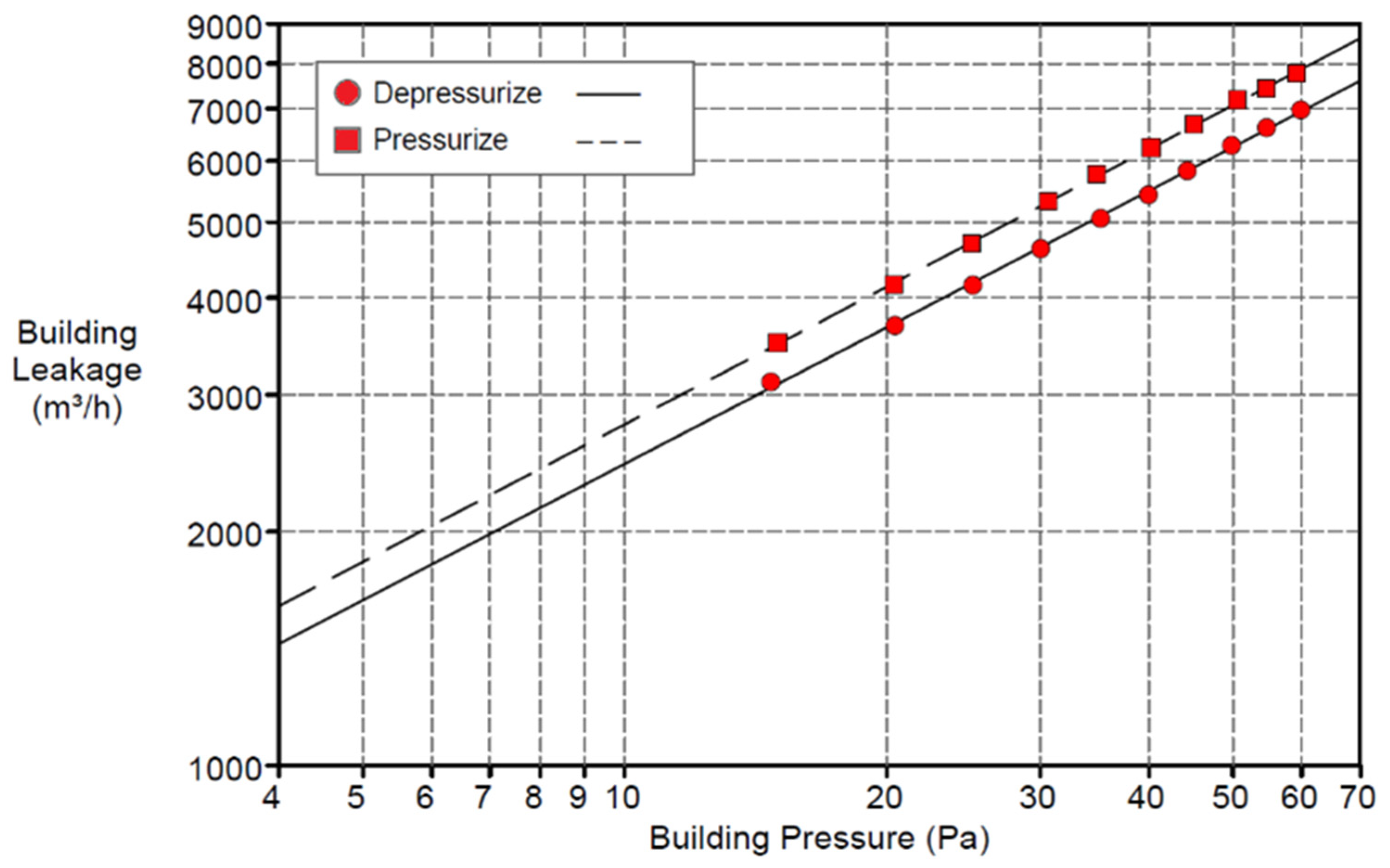
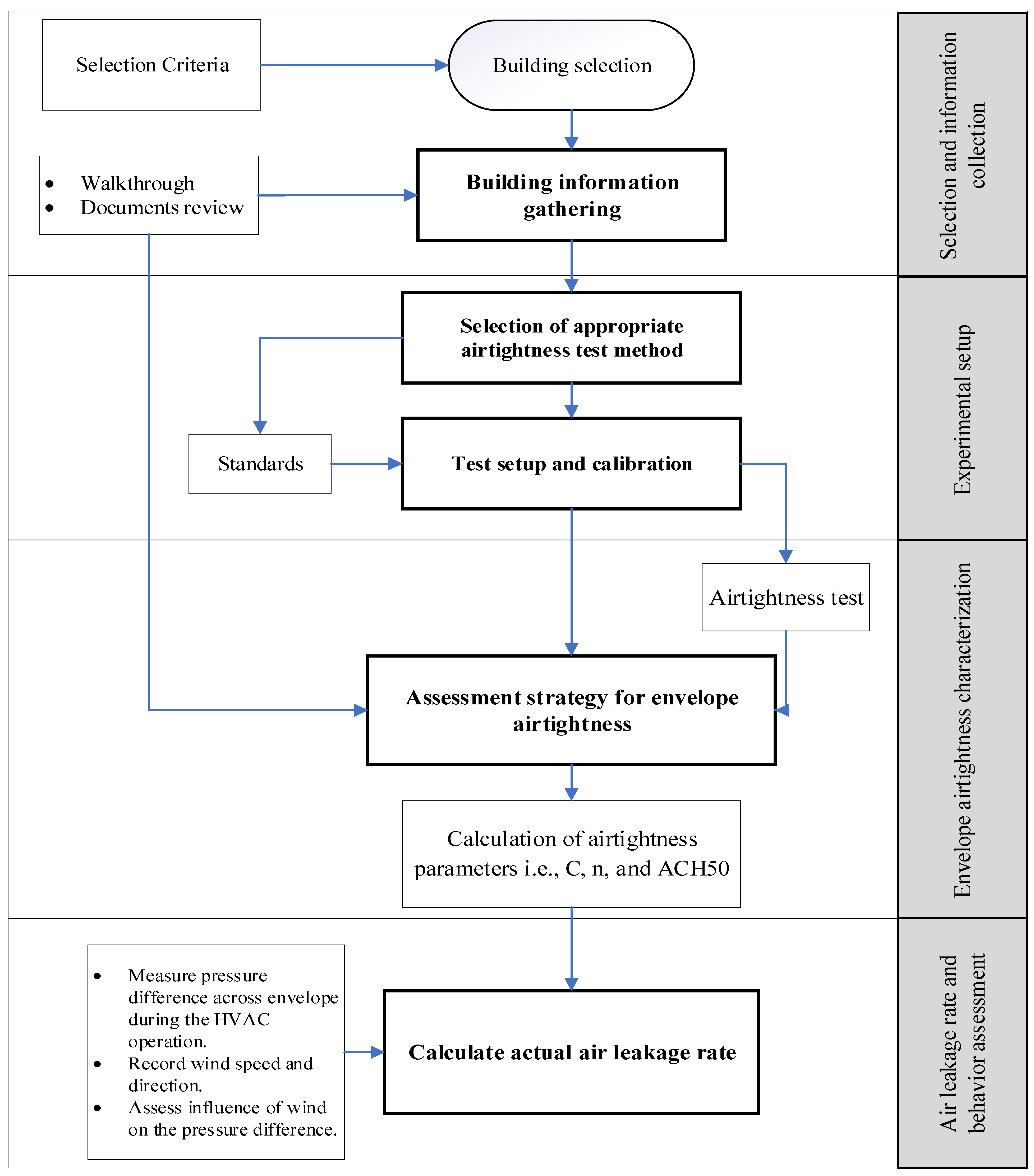
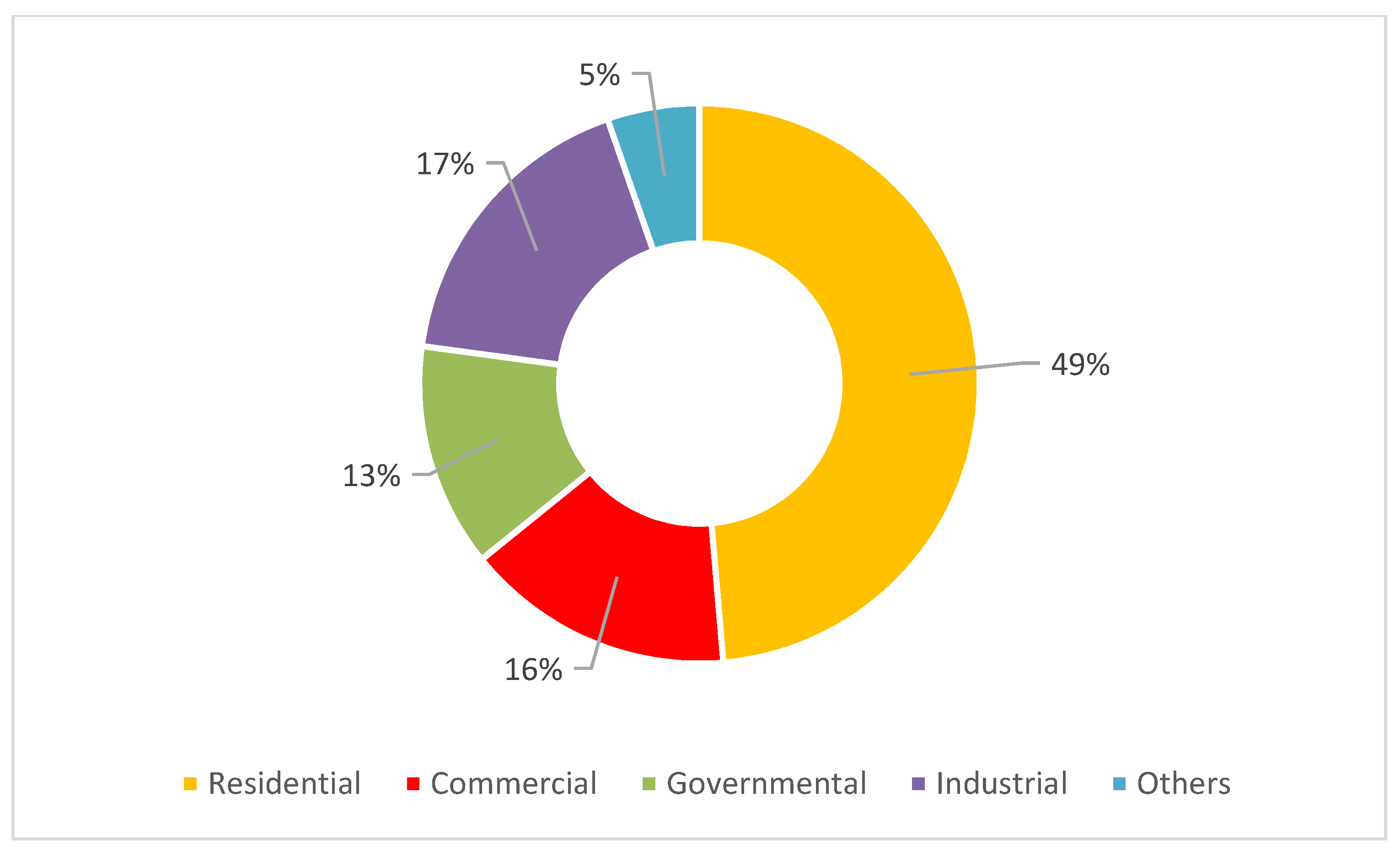
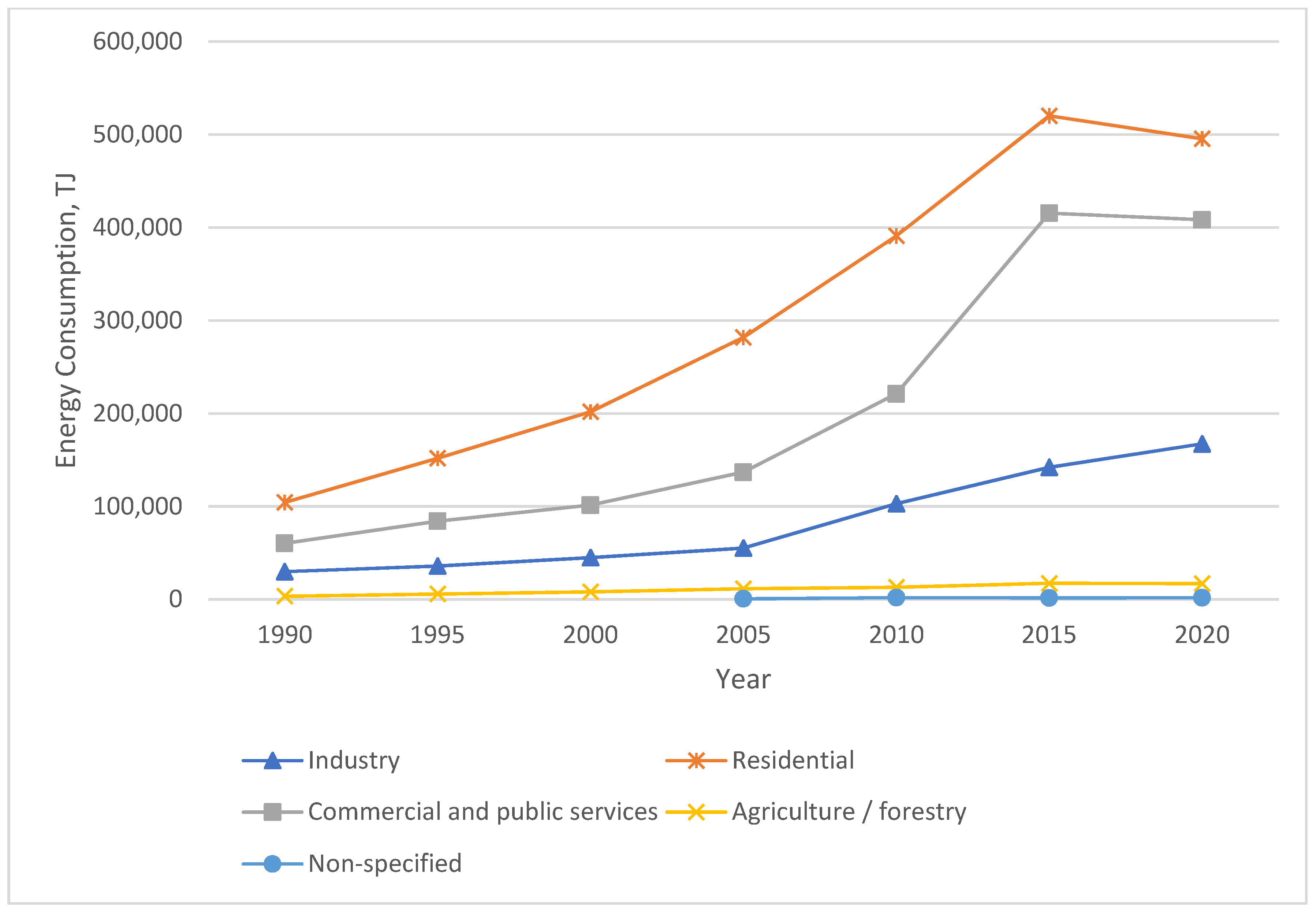
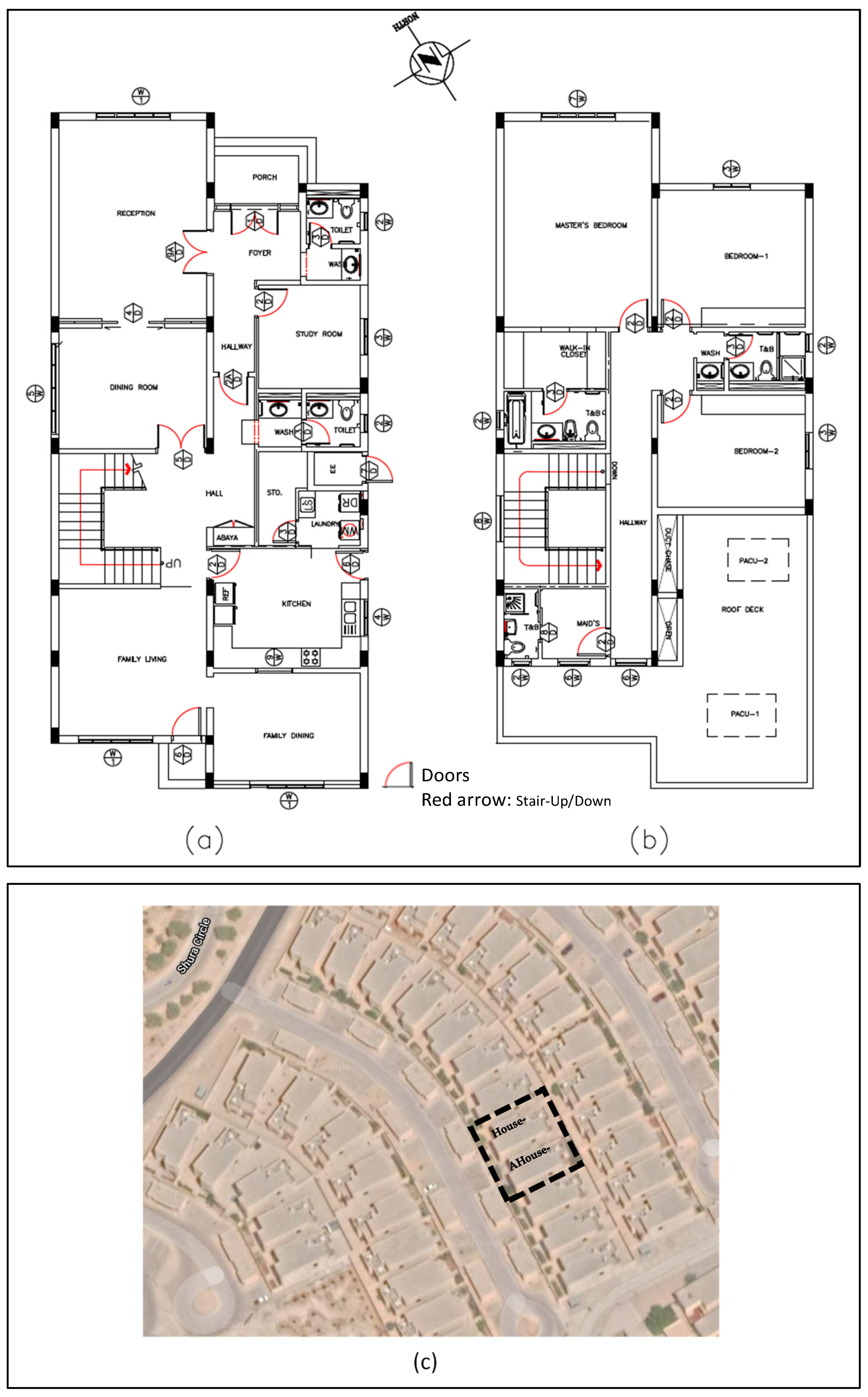
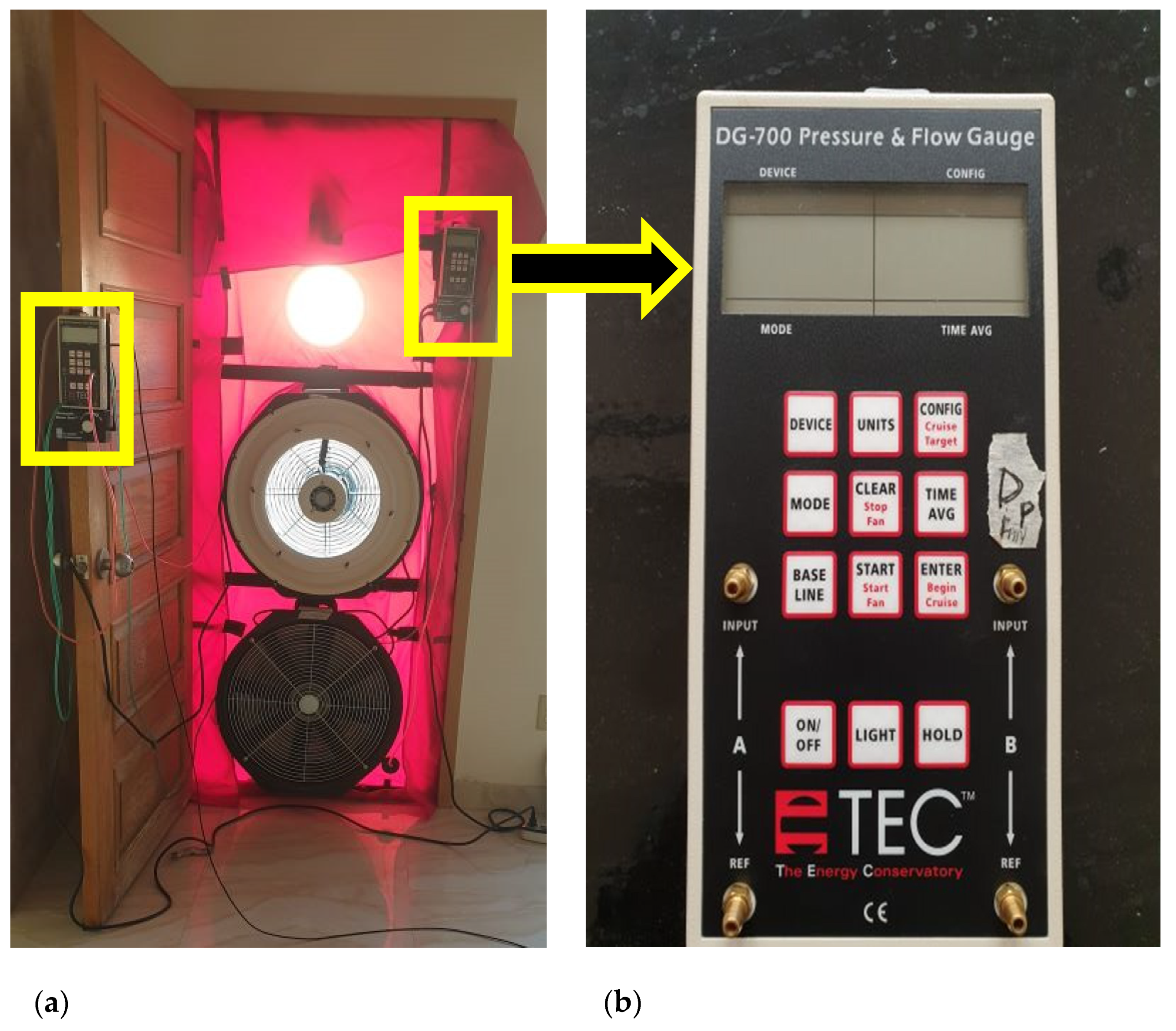

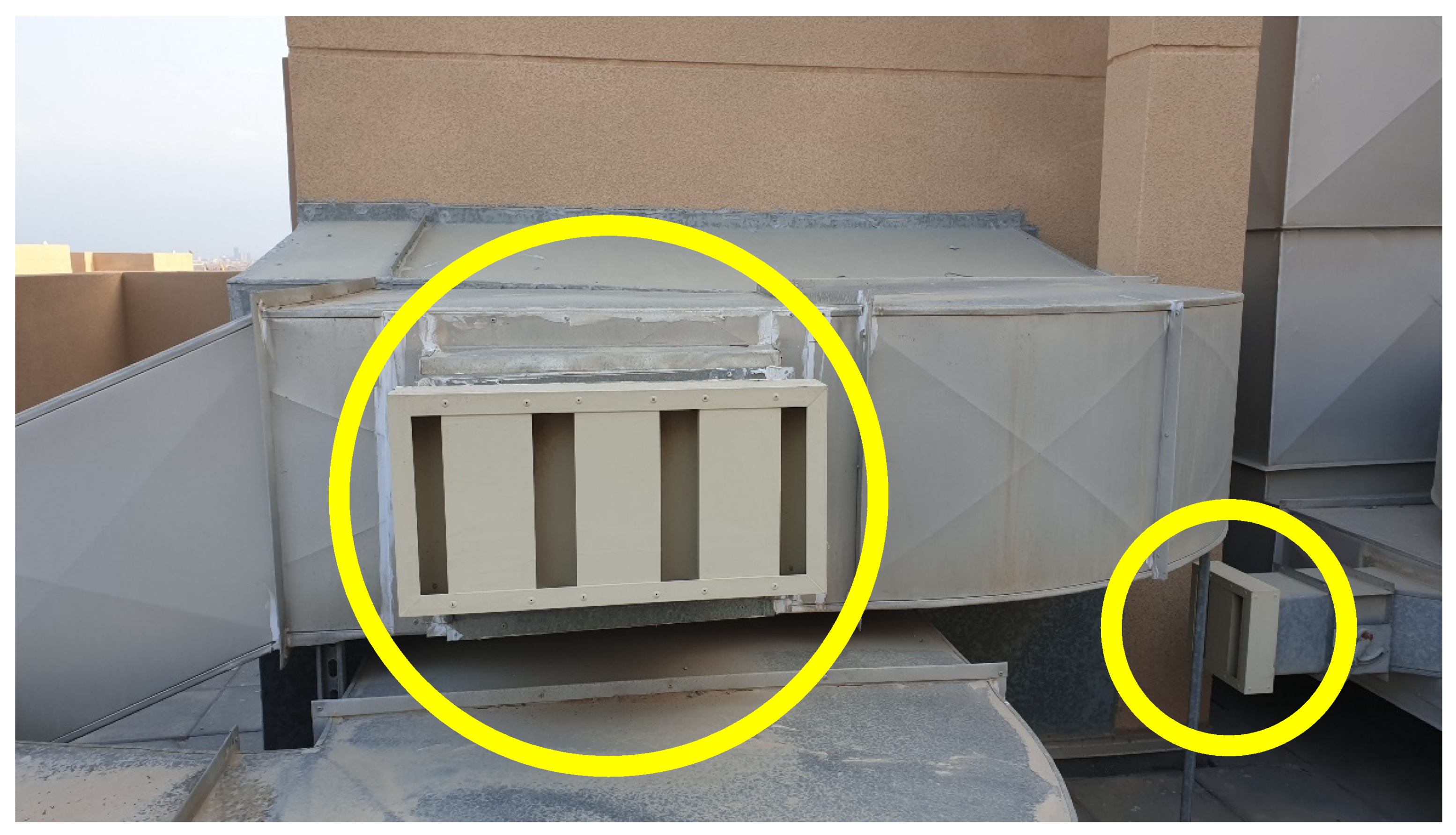
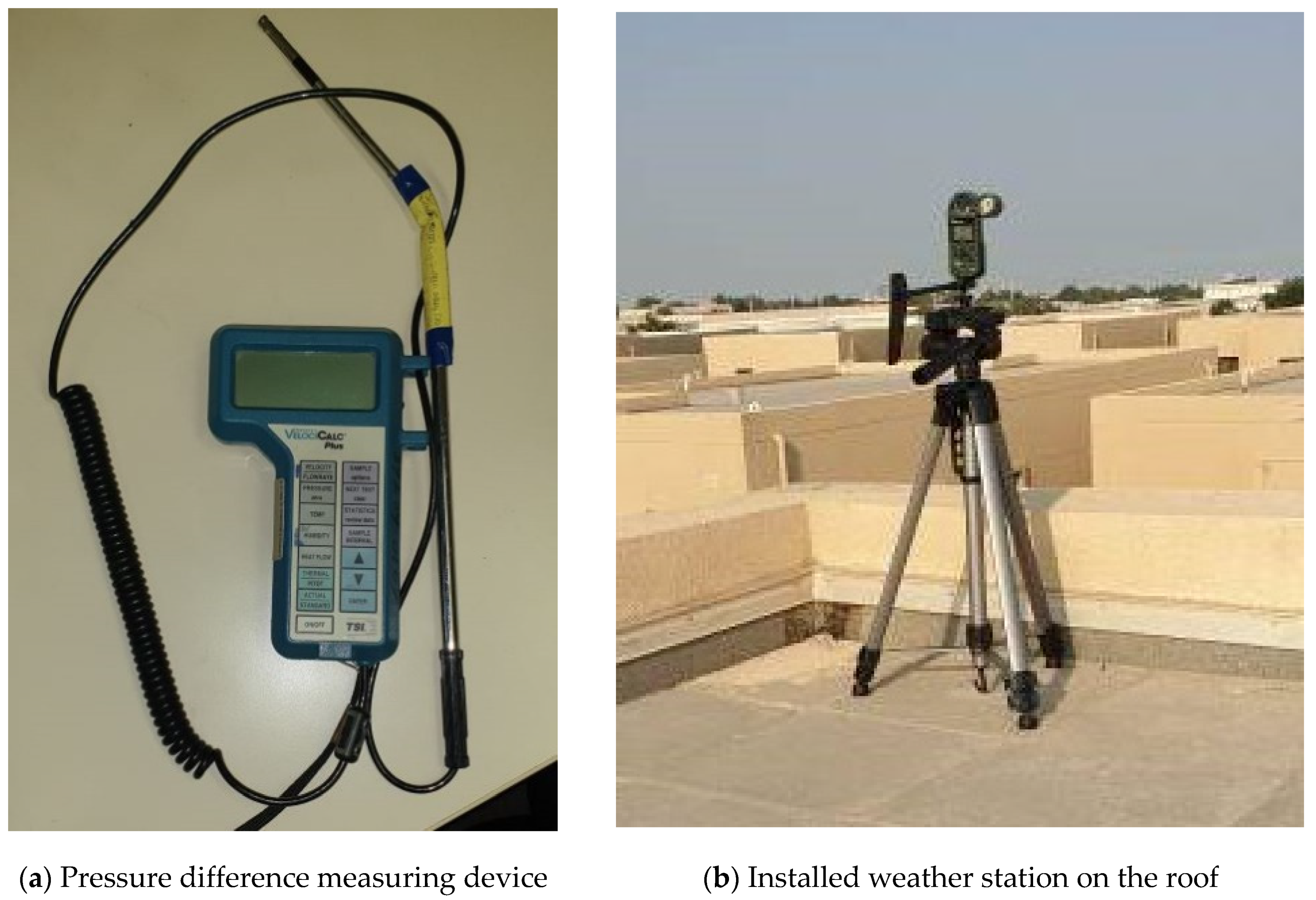

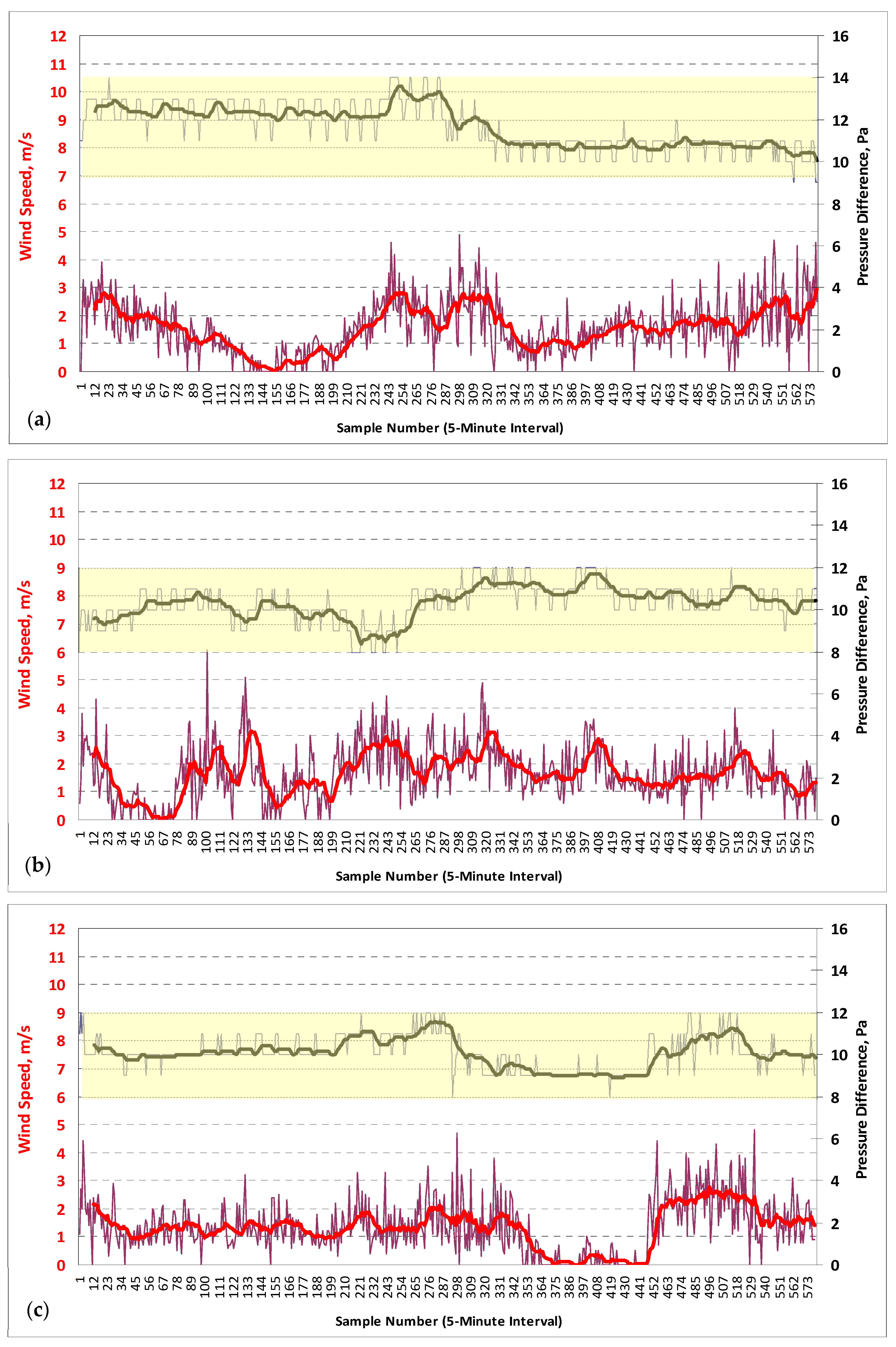

| Building Component | Percentage Range | Average Contribution |
|---|---|---|
| Walls | 18–50% | 35% |
| Cooling systems | 3–28% | 18% |
| Fireplace | 0–30% | 12% |
| Windows and doors | 6–22% | 15% |
| Vents | 2–12% | 5% |
| Others | ≤1% |
| Envelope Component | Layers: Outside to Inside | U-Value W/(m2·K) |
|---|---|---|
| External walls | 16 mm Plaster (Dense) + 100 mm Concrete Block (Medium) + 50 mm Extruded Polystyrene + 100 mm Concrete Block (Medium) + 13 mm Plaster (Lightweight) | 0.466 |
| Floor | Glazed ceramic tiles + cement mortar + dense reinforced concrete + high-density polyethylene + sand + Earth, gravel | 0.792 |
| Roof | 40 mm Concrete Tiles (Roofing) + 0.2 mm Polyethylene (High Density) + 50 mm Extruded Polystyrene + 4 mm Bitumen Felt + 59 mm Cement Screed + 300 mm Reinforced Concrete (Cast, Dense) | 0.539 |
| External windows | 4 mm Glass, generic tinted + 12 mm air gap + 6 mm Glass, generic tinted | 2.709 |
| Supply Diffusers | Return Diffusers | Exhaust Fans | MAINTENANCE. Openings+ Lighting | Doors | PRESS ACH50 (h−1) | DEPRESS ACH50 (h−1) | AVG. ACH50 (h−1) | |
|---|---|---|---|---|---|---|---|---|
| Test-1A | ◯ | ◯ | ◯ | ◯ | ◯ | 6.83 | 6.34 | 6.58 |
| Test-2A | ◯ | ◯ | ● | ◯ | ◯ | 6.64 | 6.30 | 6.47 |
| Test-3A | ● | ● | ● | ◯ | ◯ | 5.57 | 5.72 | 5.64 |
| Test-4A | ● | ● | ◯ | ◯ | ◯ | 6.51 | 6.04 | 6.27 |
| Teat-5A | ● | ◯ | ◯ | ◯ | ◯ | 6.95 | 6.70 | 6.82 |
| Test-6A | ● | ◯ | ● | ◯ | ◯ | 6.82 | 6.69 | 6.76 |
| Test-7A | ◯ | ● | ● | ◯ | ◯ | 6.89 | 7.07 | 6.98 |
| Test-8A | ◯ | ● | ◯ | ◯ | ◯ | 6.86 | 6.45 | 6.65 |
| Test-9A | ● | ● | ● | ● | ◯ | 4.68 | 5.39 | 5.03 |
| Test-10A | ● | ● | ● | ● | ● | 4.32 | 4.11 | 4.22 |
 Base case scenarios.
Base case scenarios.| Supply Diffusers | Return Diffusers | Exhaust Fans | MAINTENANCE. Openings+ Lighting | Doors | PRESS. ACH50 (h−1) | DEPRESS. ACH50 (h−1) | AVG. ACH50 (h−1) | |
|---|---|---|---|---|---|---|---|---|
| Test-1B | ◯ | ◯ | ◯ | ◯ | ◯ | 7.43 | 6.65 | 7.04 |
| Test-2B | ◯ | ◯ | ● | ◯ | ◯ | 7.41 | 6.57 | 6.99 |
| Test-3B | ● | ● | ● | ◯ | ◯ | 4.81 | 4.89 | 4.85 |
| Test-4B | ● | ● | ◯ | ◯ | ◯ | 6.72 | 5.97 | 6.34 |
| Test-5B | ● | ◯ | ◯ | ◯ | ◯ | 7.56 | 6.68 | 7.12 |
| Test-6B | ● | ◯ | ● | ◯ | ◯ | 7.16 | 6.44 | 6.80 |
| Test-7B | ◯ | ● | ● | ◯ | ◯ | 6.48 | 6.07 | 6.27 |
| Test-8B | ◯ | ● | ◯ | ◯ | ◯ | 7.12 | 6.29 | 6.71 |
| Test-9B | ● | ● | ● | ● | ◯ | 4.24 | 4.56 | 4.40 |
| Test-10B | ● | ● | ● | ● | ● | 3.41 | 3.38 | 3.40 |
 Base case scenarios.
Base case scenarios.| House A | House B | |||
|---|---|---|---|---|
| ACH50 | % | ACH50 | % | |
| Exhaust fans | 0.11 | 4.66% | 0.05 | 1.37% |
| Maintenance and lighting openings | 0.72 | 30.51% | 1.89 | 51.92% |
| Doors | 0.70 | 29.66% | 1.00 | 27.47% |
| HVAC system | 0.83 | 35.17% | 0.70 | 19.23% |
| Total | 2.36 | 3.64 | ||
| Direction Dominance (%) | Wind Speed Dominance (%) | |||||||||||||||
|---|---|---|---|---|---|---|---|---|---|---|---|---|---|---|---|---|
| Main Directions | Wind Speed Ranges, m/s | |||||||||||||||
| House | Day | Side | Door | N | NE | E | SE | S | SW | W | NW | 0–1 | 1–2 | 2–3 | 3–4 | 4–5 |
| House A | Day-1 | East-Side | Back Door | 3 | 43 | 7 | 15 | 11 | 20 | 0 | 0 | (35) | (36) | 22 | 6 | 1 |
| Day-2 | East-Side | Back Door | 11 | 3 | 0 | 0 | 0 | 2 | 40 | 44 | 20 | (46) | (22) | 10 | 3 | |
| Day-3 | West-Side | Front Door | 6 | 3 | 0 | 7 | 41 | 13 | 25 | 6 | (33) | (32) | 20 | (13) | 2 | |
| Day-4 | West-Side | Front Door | 18 | 53 | 25 | 1 | 0 | 0 | 1 | 1 | 13 | (53) | (27) | 6 | 1 | |
| Day-5 | North-Side | Kitchen Door | 14 | 3 | 0 | 0 | 0 | 9 | 62 | 13 | 26 | (55) | 17 | 2 | 0 | |
| Day-6 | North-Side | Kitchen Door | 1 | 1 | 0 | 6 | 12 | 1 | 35 | 44 | (46) | (25) | 20 | 7 | 2 | |
| House B | Day-7 | North-Side | Kitchen Door | 0 | 14 | 63 | 21 | 2 | 0 | 0 | 0 | (44) | (33) | 18 | 5 | 0 |
| Yellow-highlighted | The two dominant directions (%) | Green-highlighted | The highest two dominant wind speeds (%) | |||||||||||||
| C(m3/h·Pan) | n | ∆P(Pa) | Q(m3/h) | ACH(h−1) | |
|---|---|---|---|---|---|
| Test-1A | 650.85 | 0.578 | 11 | 2602.6 | 2.79 |
| Test-5A | 700.8 | 0.566 | 11 | 2722.8 | 2.90 |
| Test-1B | 664 | 0.588 | 9 | 2416.9 | 2.58 |
| Test-5B | 661.7 | 0.578 | 9 | 2356.2 | 2.51 |
Disclaimer/Publisher’s Note: The statements, opinions and data contained in all publications are solely those of the individual author(s) and contributor(s) and not of MDPI and/or the editor(s). MDPI and/or the editor(s) disclaim responsibility for any injury to people or property resulting from any ideas, methods, instructions or products referred to in the content. |
© 2023 by the authors. Licensee MDPI, Basel, Switzerland. This article is an open access article distributed under the terms and conditions of the Creative Commons Attribution (CC BY) license (https://creativecommons.org/licenses/by/4.0/).
Share and Cite
Makawi, M.A.; Budaiwi, I.M.; Abdou, A.A. Characterization of Envelope Air Leakage Behavior for Centrally Air-Conditioned Single-Family Detached Houses. Buildings 2023, 13, 660. https://doi.org/10.3390/buildings13030660
Makawi MA, Budaiwi IM, Abdou AA. Characterization of Envelope Air Leakage Behavior for Centrally Air-Conditioned Single-Family Detached Houses. Buildings. 2023; 13(3):660. https://doi.org/10.3390/buildings13030660
Chicago/Turabian StyleMakawi, Mohamed A., Ismail M. Budaiwi, and Adel A. Abdou. 2023. "Characterization of Envelope Air Leakage Behavior for Centrally Air-Conditioned Single-Family Detached Houses" Buildings 13, no. 3: 660. https://doi.org/10.3390/buildings13030660
APA StyleMakawi, M. A., Budaiwi, I. M., & Abdou, A. A. (2023). Characterization of Envelope Air Leakage Behavior for Centrally Air-Conditioned Single-Family Detached Houses. Buildings, 13(3), 660. https://doi.org/10.3390/buildings13030660







